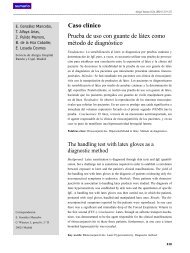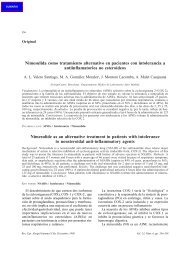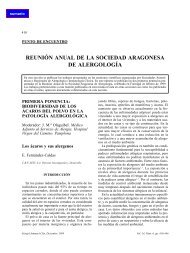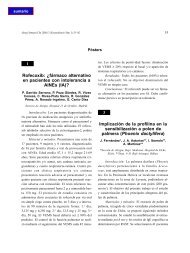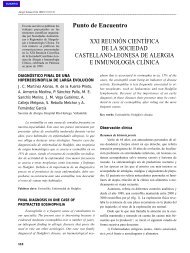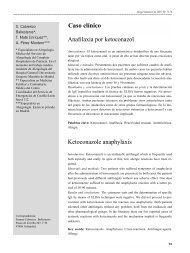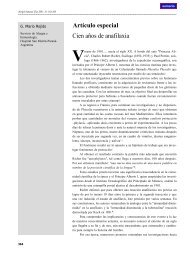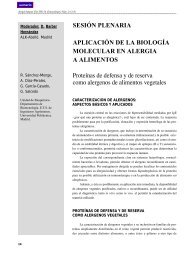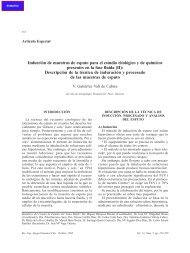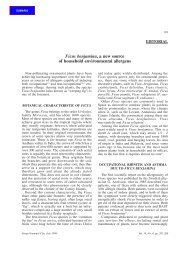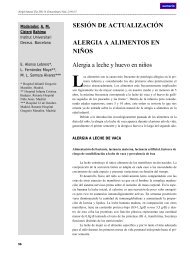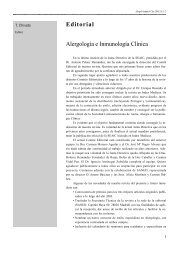Antihistamines: a review
Antihistamines: a review
Antihistamines: a review
Create successful ePaper yourself
Turn your PDF publications into a flip-book with our unique Google optimized e-Paper software.
No. 5 H1 <strong>Antihistamines</strong>: a <strong>review</strong> 301<br />
CHEMISTRY OF THE ANTIHISTAMINES<br />
The typical antihistamines have an ethylamine<br />
side chain (similar to that of histamine itself)<br />
which is united to one or more cyclic groups. The<br />
structural characteristics of the H1 receptor antagonists<br />
have been historically used for classifying<br />
them into six broad chemical families: ethanolamines,<br />
ethylenediamines, alkylamines, phenothiazines,<br />
piperazines and piperidines (Table I) 6 .<br />
Several of the new H1 receptor antagonists are<br />
chemically speaking piperidines, or at least they<br />
possess piperidine rings (Fig. 1). Many of them<br />
are direct derivatives of the parent compound or<br />
active metabolites of the primary molecules (such<br />
as cetirizine from hydroxyzine, or fexofenadine<br />
from terfenadine) 6 .<br />
Generally, the molecular nucleus of the H1 receptor<br />
antagonists is necessary for their H1 affinity and<br />
selectivity, while the side chains or radicals influence<br />
other properties of the molecules. As an example,<br />
the first-generation antihistamines contain aromatic<br />
rings and alkyl substituents which render them<br />
lipophyllic, thus explaining their ability to cross the<br />
haemato-encephalic barrier (HEB) 7 . Efforts have<br />
been directed at suppressing or preventing this property<br />
by adding or eliminating radicals in the molecular<br />
structure; thus, terfenadine requires its phenylbutanol<br />
structure in order not to cross the HEB 4,8 ,<br />
and loratadine has a carboxyethyl ester radical which<br />
limits its distribution in the CNS 9 .<br />
The ethylamine group, which is common to all<br />
typical antihistamines, is also shared by many anticholinergic<br />
and adrenergic blocking compounds.<br />
For this reason, these compounds have antidopaminergic,<br />
antiserotoninergic and antimuscarinic<br />
effects, which in many patients become undesirable<br />
side effects. They have, however, also been taken<br />
advantage of for therapeutic purposes: the antiemetic<br />
and antikinetotic actions of many antihistamines<br />
(diphenhydramine, dimenhydrinate, phenothiazines)<br />
are predominantly due to their central sedative<br />
and anticholinergic properties 9 . Some antihistamines,<br />
such as cyproheptadine, ketotifen, astemizole<br />
and cetirizine also induce increased appetite, which<br />
has been ascribed to an antiserotoninergic action 9 .<br />
This undesired side effect, which is well documented<br />
particularly in the case of cyproheptadine, has<br />
been often taken advantage of in "reconstituents"<br />
and preparations for the treatment of hypo-orexia 10 .<br />
Table I. Chemical classification of the H1 antihistamines<br />
Chemical group Typical compounds Second-generation<br />
(first generation) compounds<br />
Alkylamines Bromphenyramine Acrivastine<br />
Chlorphenyramine<br />
Triprolidine<br />
Ethanolamines Diphenhydramine<br />
Dimenhydrinate<br />
Doxylamine<br />
Carbinoxamine<br />
Clemastine<br />
Ethylenediamines Pirylamine<br />
Tripelennamine<br />
Antazoline<br />
Phenothiazines Promethazine Mequitazine<br />
Piperazines Buclyzine, Ciclyzine<br />
Cinarizine, Flunarizine Oxatomide<br />
Hydroxyzine Cetirizine<br />
Piperidines Azatadine Loratadine<br />
Cyproheptadine Astemizole<br />
Ketotifen Levocabastine<br />
Mizolastine<br />
Ebastine<br />
Terfenadine<br />
Fexofenadine<br />
Miscellany Azelastine<br />
(ftalazinone<br />
derivative)<br />
MECHANISMS OF ACTION<br />
The antihistamines behave as competitive antagonists<br />
of histamine: they bind to the H1 receptor<br />
without activating it, and thus prevent histamine<br />
from binding to and activating this receptor. The<br />
binding of many antihistamines is readily reversible<br />
but some of them, such as terfenadine and<br />
astemizole, are not easily dissociated from their<br />
binding to the receptors 11 . Even though there are<br />
some specific molecules for which such effects<br />
have been documented, antihistamines as a group<br />
do not chemically inactivate histamine, nor do<br />
they antagonise it in a physiological sense, nor do<br />
they in any manner prevent its release 9 .<br />
Many recent studies suggest that some H1<br />
receptor antagonists might also have antiinflammatory<br />
or antiallergic properties in the broadest<br />
sense of those concepts. Although the first publication<br />
in this context referred to azatadine 12 , this<br />
type of additional actions has been later attributed<br />
to many second-generation antihistamines.




